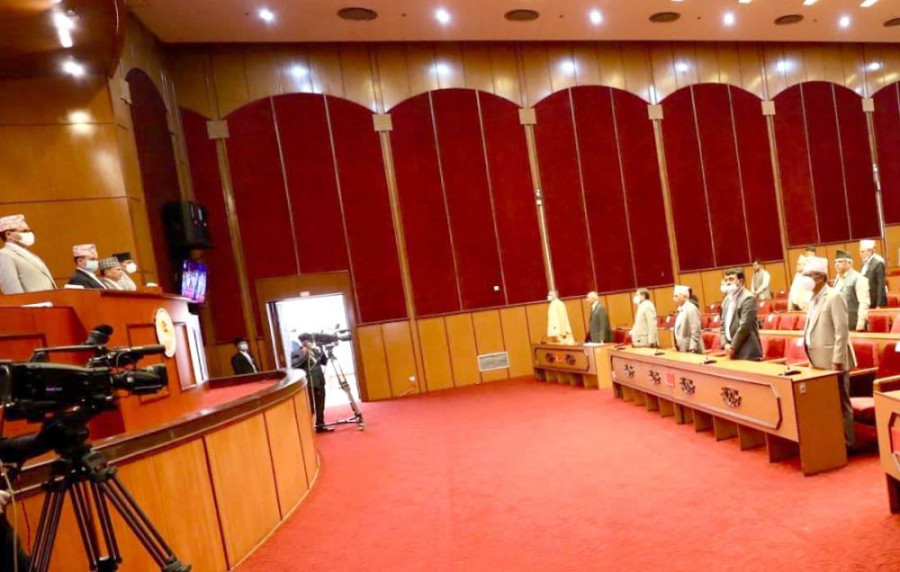National
With their tactical plans, parties reluctant to join hands against Oli in upper house
Though they had agreed to jointly table a resolution motion against the ‘unconstitutional’ lower house dissolution, they now seem to be taking possible polls into consideration.
Binod Ghimire
When President Bidya Devi Bhandari called the winter session of the National Assembly on January 1, leaders from the Pushpa Kamal Dahal and Madhav Kumar Nepal-led faction of the Nepal Communist Party, the Nepali Congress and the Janata Samajbadi Party said they would join hands in the upper house to protest against the the dissolution of the House of Representatives.
The endorsement of a resolution motion in the 59-member Assembly calling the dissolution of the House unconstitutional would mean that the permanent parliament, as the upper house is also called, has accepted that the dissolution was unconstitutional.
But even a week after the winter session began, the parties are not sure about the resolution motion.
“We are still holding discussions. The resolution motion will be submitted,” Anita Devkota, Nepali Congress whip in the National Assembly, told the Post. “However, I cannot say when.”
She said since the issue needs to be decided by the top leadership of the party, decision on it is taking time.
But the reasons why parties are reluctant to endorse such a move are more tactical, according to political analysts.
They say although the parties are protesting the move of KP Sharma Oli’s Cabinet, restoration of the House of Representatives doesn’t seem to be their sole agenda.
“It seems they are preparing themselves for the election simultaneously while also demanding the revocation of the dissolution. Be it Nepali Congress or Janata Samajbadi Party, they are sailing on two boats,” Puranjan Acharya, a political commentator who follows the Nepali Congress closely, told the Post. “When you aim for multiple targets, you definitely don’t focus on one.”
The Nepali Congress and Janata Samajbadi Party have six and three lawmakers respectively in the National Assembly. Oli and Dahal-Nepal factions have about the same strength of the Nepal Communist Party’s 50 members.
A resolution motion can get through the upper house if the three sides that have denounced the December 20 dissolution come together.
“The National Assembly would ask the government to revoke its decision if the motion was endorsed. Although the endorsement doesn’t have a legal implication, it definitely has a political meaning,” Prakash Pantha, a Nepali Congress lawmaker, told the Post. “We will pressure the party leadership for it, which hasn’t felt its urgency.”
But Nepali Congress President Sher Bahadur Deuba is reluctant to oppose Oli too strongly, amid reports that there is an understanding between him and Oli for an alliance of sorts if the House is restored.
Geja Sharma Wagle, a columnist for Kantipur, the Post’s sister publication, said the Congress establishment faction is busy calculating the political gains of participating in the elections.
“It sees the split in the Nepal Communist Party as an opportunity to fare better than in the previous elections,” said Wagle.
In the 2017 general elections, the Nepali Congress, which had been in power for most of the time since the restoration of multiparty democracy in 1990, won a mere 63 seats in the 275-member House of Representatives.
“This is the reason why neither street protests are as effective as they could have been, nor the opposition parties have unanimous voice in the National Assembly,” said Acharya.
The protests against the dissolution too seem to be the rallies for the elections, said Acharya.
Midterm polls have been set for April 30 and May 10 and will go ahead unless the Supreme Court reinstates the House. The hearing on the constitutionality of Oli’s move, which has been challenged in court, is ongoing with the next hearing set for January 13.
Although political parties have been protesting the dissolution, they are not strong and united.
Nepali Congress rejected the proposal of the Dahal-Nepal faction to hold joint rallies and this made the Janata Samajbadi Party too drop its earlier plan for joint protests.
“Parties other than the Dahal-Nepal faction of the Nepal Communist Party are on the streets only because the civil society, professional organisations and the media are dragging them there,” said Acharya.
The half-hearted street protests also reflect in the National Assembly.
“The opposition parties could increase the momentum against the unconstitutional move through the National Assembly but sadly they haven’t,” said Wagle.
The meeting of the National Assembly has been held twice since it was convened where the members, except those close to the Oli faction, have condemned the decision to dissolve the House.
Other than putting forth their views, the upper house members haven’t followed other parliamentary processes to hold the Oli government to account.
If the voice against the dissolution gets too strong, the House session could be prorogued soon, as experts have suggested.
Speaking to a news agency on January 3, Ganesh Timilsina, chair of the National Assembly and an Oli ally, had hinted that the winter session might not last long.
“The only way the assembly can work effectively is if the government creates a favourable environment to do so. Even if the government does bring new bills for it to become law, we need the House of Representatives,” he said.
But experts feel that the opportunity to endorse a resolution motion against the dissolution should not be missed.
Daman Nath Dhungana, former Speaker of the House of Representatives and a civil society leader, said the upper house should opt for the resolution motion against the dissolution.
“The House, primarily, is the place to ventilate the grievances of the people,” he told the Post. “It can also demand answers from the minister and even the prime minister.”
Dhungana said if the parties want to give momentum to the protests against the ‘unconstitutional’ move, they should have a united voice both in Parliament and on the streets.
But parties seem to be divided on the way forward and seem to be waiting for the Supreme Court ruling.
“The protest could get momentum if the Supreme Court approves the Oli government’s decision,” said Dhungana. “The protest then, however, will not be for the reinstatement of the House but to remove Oli from leading the election government.”




 7.12°C Kathmandu
7.12°C Kathmandu















